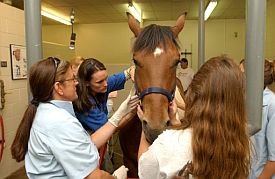Tag: "Affordability"
More from this site
CSU continues to be ranked in the top third of public universities in the U.S.
CSU was ranked the 72nd best public university in the U.S. for 2022-23. It was also ranked No. 25 on the “A+ Schools for B Students” list, the highest recognition in this category by any institution in Colorado.
Gap in state affordable housing impacts economy, reports find
The fiscal impact on local government from a lack of affordable housing is an often overlooked aspect of the affordable housing debate, and findings released in a case study of Adams County is not painting a good picture for Colorado's counties.
A joint report by Colorado Futures Center at Colorado State University and the Piton Foundation found that Adams County faced $170 million in crowded-out household spending due to a lack of affordable housing options.
Households that are cost-burdened have a dampening economic impact on sales tax revenues, and in the case of Adams County it led to a $6 million lost revenue impact to the county and its municipalities.
[caption id="attachment_7635" align="alignright" width="275" class=" "] The Adams County case study was co-authored by Phyllis Resnick of Colorado Futures Center at Colorado State University.[/caption]
“Too often affordable housing is considered only for its social benefits,” said co-author Dr. Phyllis Resnick, lead economist for the Colorado Futures Center at CSU. “However, as this study shows, there are fiscal benefits as well. This study, by identifying the fiscal benefits, will add to a more complete conversation about the true impacts of building affordable housing in Colorado."
Colorado counties struggle with affordability
Adams County has a projected population of 840,000 in 2035, making it the future largest county in the region and reflects the makeup of other counties in the state, including Denver, where the percentage of families in the county living in poverty is greater than the county's proportion of state population.
"The gap impact study specifically looks at what role local governments are playing, if any, with respect to the provision of additional support to cost burdened households, and what revenues are potentially left on the table," said co-author Jennifer Newcomer, Director of Research for The Piton Foundation at Gary Community Investments.
[caption id="attachment_7626" align="alignright" width="300"]
The Adams County case study was co-authored by Phyllis Resnick of Colorado Futures Center at Colorado State University.[/caption]
“Too often affordable housing is considered only for its social benefits,” said co-author Dr. Phyllis Resnick, lead economist for the Colorado Futures Center at CSU. “However, as this study shows, there are fiscal benefits as well. This study, by identifying the fiscal benefits, will add to a more complete conversation about the true impacts of building affordable housing in Colorado."
Colorado counties struggle with affordability
Adams County has a projected population of 840,000 in 2035, making it the future largest county in the region and reflects the makeup of other counties in the state, including Denver, where the percentage of families in the county living in poverty is greater than the county's proportion of state population.
"The gap impact study specifically looks at what role local governments are playing, if any, with respect to the provision of additional support to cost burdened households, and what revenues are potentially left on the table," said co-author Jennifer Newcomer, Director of Research for The Piton Foundation at Gary Community Investments.
[caption id="attachment_7626" align="alignright" width="300"] Households that are housing cost-burdened spend $170 million dollars less, causing almost $6 million in foregone municipal sales tax revenues for Adams County.[/caption]
The study findings show that lower income households are having a more difficult time finding affordable housing now than at the end of the Great Recession. In Adams County, nearly 80 percent of households that earn less than $35,000 spend more than 30 percent of their income on housing – the standard for when a family is housing cost-burdened.
The challenges in Adams County are consistent with local and national reports indicating the lack of affordability across the Denver metro housing market, and, as seen in a complimentary report, housing is critically important to economic health.
Looking at Colorado, trends are similar
A large-scale report released by Housing Colorado in conjunction with the Adams County case study revealed the critical role new home construction plays in the overall health of the Denver metro region, the state and the national economy.
The report, Driving a Vibrant Economy: Housing’s Role in Colorado’s Economic Success, written by Dr. Elliot Eisenberg, a nationally acclaimed economist specializing in local and national housing markets found that more housing is needed in Colorado, particularly for households earning $20,000 a year or less. According to the findings, there is a shortfall of more than 100,000 homes priced at affordable levels for these households – a gap that will take more than 100 years to eliminate based on current rates of affordable rental housing construction.
According to the study, the overall economic impact of home building in 2013 was $5.15 billion – 1.7 percent of the gross state product of Colorado. In addition, new home building and
[caption id="attachment_7624" align="alignright" width="300"]
Households that are housing cost-burdened spend $170 million dollars less, causing almost $6 million in foregone municipal sales tax revenues for Adams County.[/caption]
The study findings show that lower income households are having a more difficult time finding affordable housing now than at the end of the Great Recession. In Adams County, nearly 80 percent of households that earn less than $35,000 spend more than 30 percent of their income on housing – the standard for when a family is housing cost-burdened.
The challenges in Adams County are consistent with local and national reports indicating the lack of affordability across the Denver metro housing market, and, as seen in a complimentary report, housing is critically important to economic health.
Looking at Colorado, trends are similar
A large-scale report released by Housing Colorado in conjunction with the Adams County case study revealed the critical role new home construction plays in the overall health of the Denver metro region, the state and the national economy.
The report, Driving a Vibrant Economy: Housing’s Role in Colorado’s Economic Success, written by Dr. Elliot Eisenberg, a nationally acclaimed economist specializing in local and national housing markets found that more housing is needed in Colorado, particularly for households earning $20,000 a year or less. According to the findings, there is a shortfall of more than 100,000 homes priced at affordable levels for these households – a gap that will take more than 100 years to eliminate based on current rates of affordable rental housing construction.
According to the study, the overall economic impact of home building in 2013 was $5.15 billion – 1.7 percent of the gross state product of Colorado. In addition, new home building and
[caption id="attachment_7624" align="alignright" width="300"] Any household that spends more than 30 percent of its income on housing is considered housing cost-burdened.[/caption]
rehabilitation employed more than 81,000 workers, which is more than 2.9 percent of the entire Colorado labor force, and will result in ongoing annual recurring revenue to state and local governments of $203.3 million.
“Not only does housing meet the most basic of needs in our communities, this report demonstrates conclusively the immediate and long-term economic benefits of housing construction and rehabilitation in Colorado,” said Sara Reynolds, executive director of Housing Colorado. “A healthy local housing market includes a mix of housing types and price points that meets the needs of the entire community. This includes affordable options for working families, seniors and veterans that fosters diverse and vibrant communities, and makes economic sense.”
The reports were commissioned by a coalition of housing and community development partners, including Housing Colorado, the Colorado Municipal League, Colorado Futures Center at CSU, the Home Builders Association of Metro Denver, the Metro Denver Economic Development Corporation, Mile High Connects and The Piton Foundation.
"This report shows not only how financially important housing is to the state and local economy in terms of jobs and tax revenues, but also how critical it is to continue to build a diverse mix of housing and keep Denver affordable and vibrant,” Eisenberg said. “There is no one-size-fits-all solution; rather it will take a number of approaches to insure necessary housing gets built."
View the studies in their entirety:
Any household that spends more than 30 percent of its income on housing is considered housing cost-burdened.[/caption]
rehabilitation employed more than 81,000 workers, which is more than 2.9 percent of the entire Colorado labor force, and will result in ongoing annual recurring revenue to state and local governments of $203.3 million.
“Not only does housing meet the most basic of needs in our communities, this report demonstrates conclusively the immediate and long-term economic benefits of housing construction and rehabilitation in Colorado,” said Sara Reynolds, executive director of Housing Colorado. “A healthy local housing market includes a mix of housing types and price points that meets the needs of the entire community. This includes affordable options for working families, seniors and veterans that fosters diverse and vibrant communities, and makes economic sense.”
The reports were commissioned by a coalition of housing and community development partners, including Housing Colorado, the Colorado Municipal League, Colorado Futures Center at CSU, the Home Builders Association of Metro Denver, the Metro Denver Economic Development Corporation, Mile High Connects and The Piton Foundation.
"This report shows not only how financially important housing is to the state and local economy in terms of jobs and tax revenues, but also how critical it is to continue to build a diverse mix of housing and keep Denver affordable and vibrant,” Eisenberg said. “There is no one-size-fits-all solution; rather it will take a number of approaches to insure necessary housing gets built."
View the studies in their entirety:
College Scorecard places CSU among the top universities for quality and affordability
Colorado State University, among the nation's leading research universities, also ranks highly for graduation rates and affordability, according to the newly released College Scorecard developed by the U.S. Department of Education. World-class education
 The College Scorecard makes it easier to search information about a college’s value and affordability.
The College Scorecard makes it easier to search information about a college’s value and affordability.
“Students at CSU are getting a world-class education and outstanding undergraduate research opportunities, and the new College Scorecard shows we’re also providing an exceptional value,” CSU President Tony Frank said. “Our students are graduating at a higher rate, leaving CSU with less debt than the national average, and defaulting on their student loans at a much lower rate than their peers. In fact, thanks to our emphasis on providing more student scholarships and aid, the average net price our students pay to attend CSU went down even as tuition was going up. This is great information for students to have when they’re weighing their college options.”
CSU is the most affordable research university in Colorado while boasting a high graduation rate, according to the U.S. Department of Education. The College Scorecard also shows that the university is the only institution among Colorado’s research universities to decrease in average net price in recent years. CSU’s graduates have a low loan default rate of only 4.8 percent, while the national average is 14.7 percent. Record enrollment, high retention The high marks from the College Scorecard come at a time when CSU is consistently seeing record enrollment and strong retention rates. The College Scorecard website contains information from colleges around the country and can be found at the website. Premier research university Colorado State University is one of the nation’s premier research universities routinely highlighted in national rankings recognizing top universities and programs:
Colorado State University is one of the nation’s premier research universities routinely highlighted in national rankings recognizing top universities and programs:
- CSU is featured in the 2015 edition of Fiske Guide to Colleges. Compiled by former New York Times education editor Edward B. Fiske, The Fiske Guide includes the “best and most interesting” colleges in the nation.
- Bloomberg BusinessWeek ranked CSU’s College of Business as one of the top undergraduate business programs in the country for 2014. CSU ranked No. 73 in this year’s BusinessWeek rankings, up from No. 89 last year.
- For the fifth year in a row CSU has been named a Military Friendly School, in the company of the top 15 percent of all colleges, universities and trade schools. The list, published by GI Jobs magazine, recognizes higher education institutions that embrace America’s military service members, veterans and spouses as students and ensure their success on campus.
- Fashion-Schools.org ranked CSU’s Department of Design and Merchandising in the upper echelon of fashion design and merchandising programs in the nation for 2014. CSU’s department was ranked ninth in the country in the fashion merchandising category and 16th nationally for fashion design. CSU was ranked second in the Southwest region in both fields.
- CSU’s College of Agricultural Sciences programs rank in the top 10 percent of the world’s best universities according to the 2013 Academic Ranking of World Universities.
- CSU’s College of Business ranks in the top 15 percent of the world’s best universities for its research, according to the 2013 Academic Ranking of World Universities.
- CSU is listed among the nation’s best universities by Princeton Review, a New-York-based educational services company. Students surveyed say that CSU is a “hidden gem” that offers a “wonderful education, friendly people, and awesome culture,” along with “excellent” green efforts, a strong engineering program, and myriad research opportunities. CSU also cares about its students becoming active members in the community, according to the 2014 Princeton Review “Best 378 Colleges.”
- CSU is among Forbes’ Top Colleges for 2013. The university ranks among the top Research Universities and Universities in the West.
 CSU’s professional doctoral veterinary medicine program is ranked No. 3 in the nation according to U.S. News and World Report’s 2014 Best Graduate Schools edition. The College of Veterinary Medicine and Biomedical Sciences consistently places among the top three vet schools in the nation. It is also ranked third in the nation in federal research dollars.
CSU’s professional doctoral veterinary medicine program is ranked No. 3 in the nation according to U.S. News and World Report’s 2014 Best Graduate Schools edition. The College of Veterinary Medicine and Biomedical Sciences consistently places among the top three vet schools in the nation. It is also ranked third in the nation in federal research dollars.- The professional program in the Department of Occupational Therapy in CSU’s College of Health and Human Sciences - designated a “Program of Excellence” by the state of Colorado - ranks No. 6 among similar programs nationwide according to U.S. News and World Report in its 2014 Best Graduate Schools edition.
- CSU’s College of Business part-time MBA program was ranked 34th in the nation in the U.S. News and World Report’s 2014 Best Graduate Schools edition. The program was the highest ranked one of its kind in Colorado.
- CSU’s graduate programs in science, engineering and business also were recognized as some of the best in the nation by U.S. News and World Report in its 2014 Best Graduate Schools edition. Civil engineering and chemistry were both ranked in the top 50.
- CSU’s online Psychology undergraduate degree completion program, Human Development and Family Studies undergraduate degree completion program, Master of Engineering, Civil Engineering specialization and Master of Computer Science and Information Technology were independently reviewed and ranked by GetEducated.com as top "Best Buys.” The data-driven lists spotlight the most affordable online degrees from regionally accredited colleges.
- CSU’s College of Business is among the “Best Administered” business schools in the nation according to Princeton Review. CSU’s College of Business ranks fourth in the nation in the “Best 296 Business Schools” book for 2013.